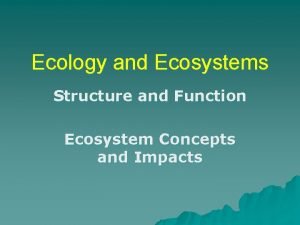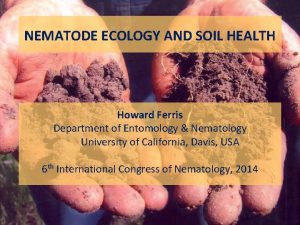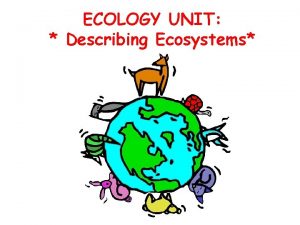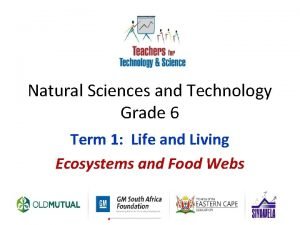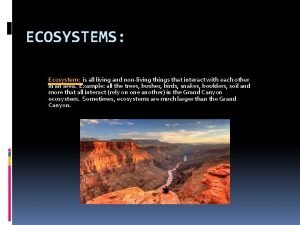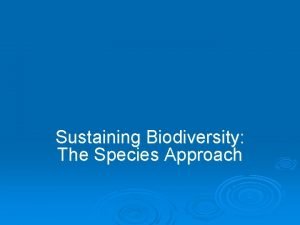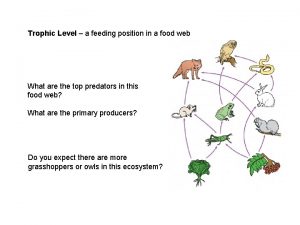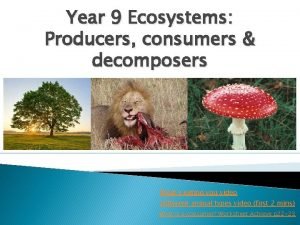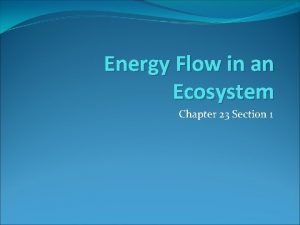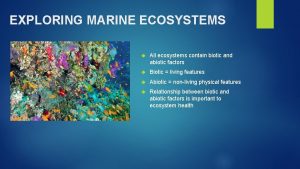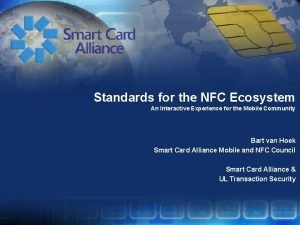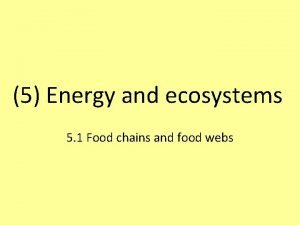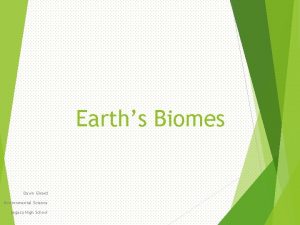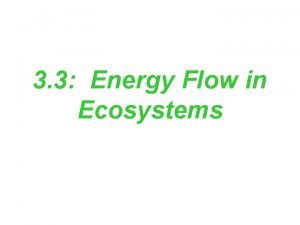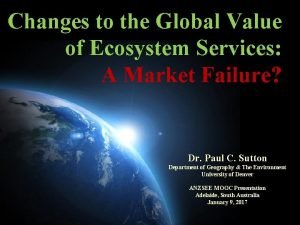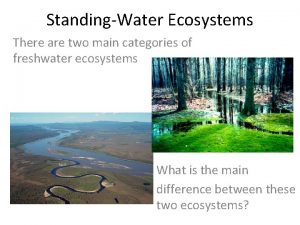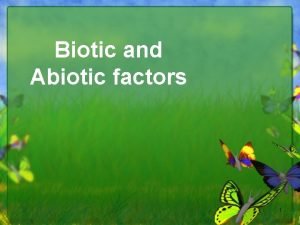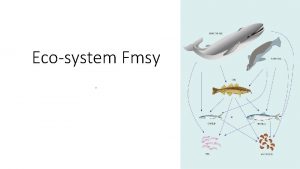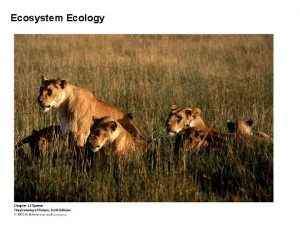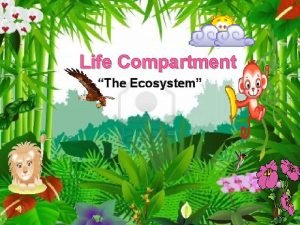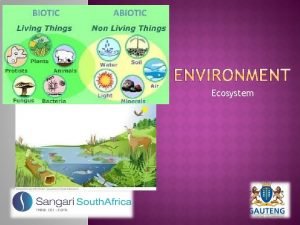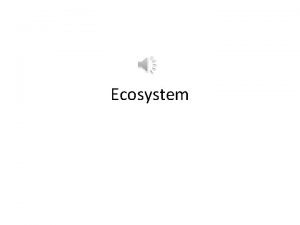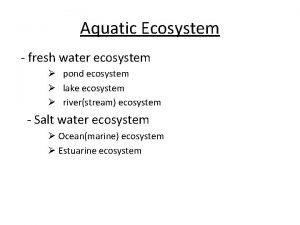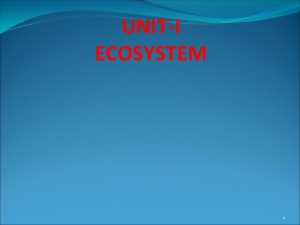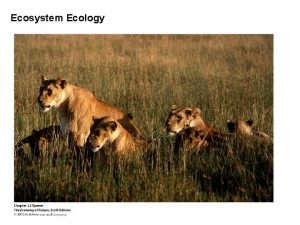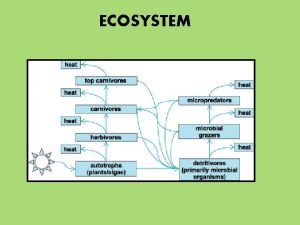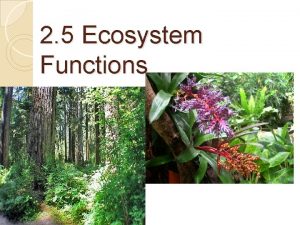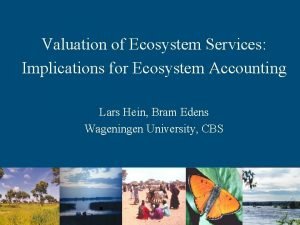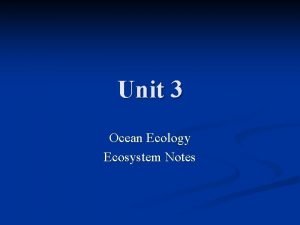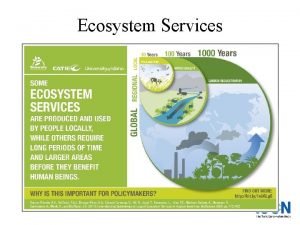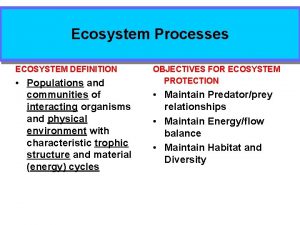FUNCTIONS OF AN ECOSYSTEM FUNCTIONS OF AN ECOSYSTEM





















- Slides: 21

FUNCTIONS OF AN ECOSYSTEM

FUNCTIONS OF AN ECOSYSTEM • Ecosystem functions mainly comprise the interactions of various components in an ecosystem • They are interconnected by energy, nutrients and minerals • The survival of an ecosystem depends on – Flow of energy-- Non cyclic food chain – Biogeochemical cycle –Cyclic food chain - circulation of nutrients and minerals

Important functions of an ecosystem are • • • Energy Primary production Secondary production Food chain Food web Trophic levels Energy flow Ecological pyramid Biogeochemical cycles

ENERGY FLOW • Energy is the ability to do work • Main source - the radiant energy or light energy derived from the sun Energy Trapped Producers Utilized Consumers Consumed Secondary consumer

SOURCE OF ENERGY • Ecosystems - composed of a variety of abiotic components such as soil, water, atmosphere, radiation from the sun • Soils provide nutrients, water act as home and a medium for organisms • The atmosphere provides carbon dioxide for photosynthesis and oxygen for respiration Solar radiation 2 cal / sq. cm. /min Earth surface (Solar flux or solar constant) 95 -99% Lost by reflection • Sunlight is necessary for photosynthesis • Photosynthesis provides the energy for plant growth and metabolism and the organic food for animal life 0. 02% Energy reach earth (Plant utilize)

• Ecosystems - composed of producers, consumers and decomposers • Producers or autotrophs - manufacture their food by photosynthesis • Consumers - get their energy and nutrients by feeding directly or indirectly on producers • Herbivores - consumers that eat plants for their energy and nutrients

• Consumer organisms that feed on this organic matter or detritus are known as detrivores or decomposers • The organic matter that is consumed by the detritivores is eventually converted back into inorganic nutrients in the soil • Energy flow and energy transformation in an ecosystem obeys the law of thermodynamics

FATE OF ENERGY

THERMODYNAMICS The first law of thermodynamics • It states that “energy can neither be created nor destroyed, but it can simply change in form” • The light energy of the sun is converted into electrical energy in the chlorophyll • The electrical energy is converted into chemical energy during photosynthesis • The chemical energy is transformed in to heat energy during metabolism • The heat energy is transformed into mechanical energy for doing work • Energy can neither created nor destroyed i. e. the energy of ecosystem is constant and thus it obeys the first law of thermo dynamics

The second law of thermodynamics • It states that “during energy transfer, large part of energy is degraded into heat and dissipates” • When energy is transferred from producers to herbivores about 90% of energy is lost as heat • The change of energy from one form to another the free energy diminishes and thus it obeys the second law of thermo dynamics

Flow of energy between phyto and zooplankton • Ecological efficiency Et = Pt Pt-1 • Et will be equal to the amount of herbivore (Pt) divided primary productivity(Pt-1 ) in marine ecosystem ie. 20% plants to herbivores and 15 -10% at higher tropic levels

ENERGY AND MATTER TRANSFER IN ECOSYSTEM • The transfer of energy from one trophic level to another is called energy flow • This flow of energy is always unidirectional and never returns back • So, energy can be utilized once in the ecosystem and otherwise it will go as waste heat

• Energy flows from one trophic level to another • Green plants or other photosynthesizing organisms use light energy from the sun to manufacture carbohydrates for their own needs • Chemical energy is processed in metabolism and dissipated as heat in respiration • Plants convert the remaining energy to biomass • The stored energy, is transferred to the second trophic level, which comprises grazing herbivores, decomposers and detrital feeders

• Energy at the second trophic level - lost as heat in respiration; fraction becomes new biomass • More steps between producer and final consumer, the less energy remains available • In a food web there are more than four links, or five levels • Energy flowing through the trophic levels is dissipated as heat • The process whereby energy loses its capacity to do work is called entropy

• The energy transfer between producers and herbivores is only 10% • Remaining 90% is lost through faces, respiration and unused energy or heat • Hence, the amount of energy available decreases from trophic level to another trophic level • Short food chain - final consumers will get a large amount of energy • Long food chain - final consumer will get a lesser amount of energy

TROPHIC STRUCTURE • The trophic structure is an arrangement of autotrophs and succeeding such of heterotrophs is called as trophic structure in which each successive consumer level is called a tropic level • Also called as feeding levels Trophic levels • Autotrophs - producers synthesis their own food by themself • Herbivores – consumers of only plants • Carnivores- consumers of only animals • Omnivores – consumers of both plants and animals • Decomposers- Decomposers of dead and decaying matters

• Each step of the food chain is called trophic level. • • • • Each food chain contains many trophic levels Autotrophs - Trophic level Herbivores – Trophic level Carnivores- Trophic level Omnivores – Trophic level Decomposers Trophic level 1 2 3 4 5

• The different feeding levels in the food chain are called trophic levels • Food chains comprised of many feeding or nourishing levels and each level is called trophic level • The first trophic level in the food chain is called primary producers, the second trophic level is primary consumers (herbivores) and the third level is primary carnivores • Lower the number of trophic levels, higher the transfer of energy to the top level organisms in the food chain • The energy transfer will be very less to the top predator, if the food chain is having more than three levels of trophic tiers

ENERGY TRANSFER- TROPHIC LEVELS • Trophic level is simply a feeding level which often represented in a food chain or food web • Primary producers - bottom of the trophic level; then primary consumers (herbivores), then secondary consumers (carnivores feeding on herbivores) and so on when we consider of moving up the food chain • It moves from plants to herbivores to carnivores • Food chain does not take into account decomposers and detritivores which make up their own trophic pathways

Energy transfer in fish production

 Consumer and producer
Consumer and producer Ecosystem functions
Ecosystem functions Functions of ecosystem
Functions of ecosystem Absolute value as a piecewise function
Absolute value as a piecewise function How to solve evaluating functions
How to solve evaluating functions Evaluating functions and operations on functions
Evaluating functions and operations on functions What is a ecosystem
What is a ecosystem Different ecosystems grade 6
Different ecosystems grade 6 Things in ecosystem
Things in ecosystem Sustaining biodiversity the species approach
Sustaining biodiversity the species approach Feeding position in a food chain
Feeding position in a food chain Producers in ecosystem
Producers in ecosystem Food web in the desert
Food web in the desert Biotic and abiotic components of marine ecosystem
Biotic and abiotic components of marine ecosystem Nfc ecosystem
Nfc ecosystem Genetic diversity vs species diversity
Genetic diversity vs species diversity Sun grass grasshopper shrew owl
Sun grass grasshopper shrew owl Grassland ecosystem
Grassland ecosystem What is feeding relationship
What is feeding relationship Changes in the global value of ecosystem services
Changes in the global value of ecosystem services What are the two main categories of ecosystems?
What are the two main categories of ecosystems? Pond ecosystem biotic and abiotic factors
Pond ecosystem biotic and abiotic factors
